High-Resolution and Large-Detection-Range Virtual Antenna Array for Automotive Radar Applications
Abstract
:1. Introduction
2. Virtual Antenna Array Concept
3. Proposed VAA Analysis
4. Proposed VAA Configurations
4.1. Synthesis of 40-Elements VAA
4.2. Synthesis of High-Gain, Low-SLL VAA
4.3. Practical Implementation of the VAA for Automotive Radars
5. Conclusions
Author Contributions
Funding
Institutional Review Board Statement
Informed Consent Statement
Data Availability Statement
Acknowledgments
Conflicts of Interest
References
- Cardillo, E.; Caddemi, A. A Review on Biomedical MIMO Radars for Vital Sign Detection and Human Localization. Electronics 2020, 9, 1497. [Google Scholar] [CrossRef]
- Hoang, H.; Johnf, M.; McEvoy, P.; Ammann, M.J. Calibration to Mitigate Near-Field Antennas Effects for a MIMO Radar Imaging System. Sensors 2021, 21, 514. [Google Scholar] [CrossRef] [PubMed]
- Miccinesi, L.; Beni, A.; Pieraccini, M. Multi-Monostatic Interferometric Radar for Bridge Monitoring. Electronics 2021, 10, 247. [Google Scholar] [CrossRef]
- Li, J. Millimetre-wave beam steering with analog-resolution and minimised distortion based on liquid crystals tunable delay lines with enhanced signal-to-noise ratios. Millimetre Wave Terahertz Sens. Technol. XIII 2020, 11541, 115410H. [Google Scholar] [CrossRef]
- Chang, H.-Y.; Wang, H.; Yu, M.; Shu, Y. A 77-GHz MMIC power amplifier for automotive radar applications. IEEE Microw. Wirel. Components Lett. 2003, 13, 143–145. [Google Scholar] [CrossRef]
- Liu, H.; Zhang, L.-J.; Peng, Y.-T.; Chen, X.-H. A novel automatic attenuator with ultra-fast response time. IEICE Electron. Express 2018, 15, 20171204. [Google Scholar] [CrossRef] [Green Version]
- Deng, H.; Himed, B. A Virtual Antenna Beamforming (VAB) Approach for Radar Systems by Using Orthogonal Coding Waveforms. IEEE Trans. Antennas Propag. 2009, 57, 425–435. [Google Scholar] [CrossRef]
- Pour, Z.A.; Shafai, L. Investigation of Virtual Array Antennas with Adaptive Element Locations and Polarization Using Parabolic Reflector Antennas. IEEE Trans. Antennas Propag. 2012, 61, 688–699. [Google Scholar] [CrossRef]
- Li, W.; Zhao, Y. A null broadening beamforming method of virtual antenna array. In Proceedings of the 2016 IEEE/ACES International Conference on Wireless Information Technology and Systems (ICWITS) and Applied Computational Electromagnetics (ACES), Honolulu, HI, USA, 5 May 2016; pp. 1–2. [Google Scholar]
- Zhang, F.; Fan, W.; Zhang, J.; Pedersen, G.F. Virtual Large-Scale Array Beamforming Analysis Using Measured Subarray Antenna Patterns. IEEE Access 2017, 5, 19812–19823. [Google Scholar] [CrossRef]
- Mbugua, A.W.; Fan, W.; Ji, Y.; Pedersen, G.F. Millimeter Wave Multi-User Performance Evaluation Based on Measured Channels with Virtual Antenna Array Channel Sounder. IEEE Access 2018, 6, 12318–12326. [Google Scholar] [CrossRef]
- Zamani, A.; Abbosh, A.M.; Crozier, S. Multistatic Biomedical Microwave Imaging Using Spatial Interpolator for Extended Virtual Antenna Array. IEEE Trans. Antennas Propag. 2017, 65, 1121–1130. [Google Scholar] [CrossRef]
- El Dosouky, B.; Abdullah, A.H.H.; Khamis, S. A new high-resolution and stable mv-svd algorithm for coherent signals detection. Prog. Electromagn. Res. M 2014, 35, 163–171. [Google Scholar] [CrossRef] [Green Version]
- El-Dawi, H.A.; Napoleon, S.A.; Hussein, A.H. VAE/MPM/GA Technique for DoA Estimation Using Optimized Antenna Arrays. Wirel. Pers. Commun. 2016, 92, 1271–1279. [Google Scholar] [CrossRef]
- Yahia, A.A.; Elkamchouchi, H.M. Design of Virtual Antenna Array for Direction of Arrival Estimation Using Real Antenna Array System. In Proceedings of the 2019 34th International Technical Conference on Circuits/Systems, Computers and Communications (ITC-CSCC), Jeju, Korea, 23–26 June 2019; pp. 1–3. [Google Scholar]
- Abdullah, A.H.H.A.; Mabrouk, M.H.; Abdullah, H.H. A Super Resolution and Highly Stable Technique for Direction of Arrival Estimation of Coherent Sources for mm-Wave Radars. Prog. Electromagn. Res. B 2020, 88, 53–71. [Google Scholar] [CrossRef]
- Wang, W.-Q. Virtual Antenna Array Analysis for MIMO Synthetic Aperture Radars. Int. J. Antennas Propag. 2012, 2012, 1–10. [Google Scholar] [CrossRef]
- Dahl, C.; Rolfes, I.; Vogt, M. Comparison of virtual arrays for MIMO radar applications based on hexagonal configurations. In Proceedings of the 2015 European Microwave Conference (EuMC), Paris, France, 7–10 September 2015; pp. 1439–1442. [Google Scholar]
- Zhao, X.; Zhang, W.; He, Z.; Li, J. Performance analysis of airborne LFMCW-MIMO vitual array radar. In Proceedings of the 2016 CIE International Conference on Radar (RADAR), Guangzhou, China, 10–13 October 2016; pp. 1–5. [Google Scholar]
- Hott, M.; Mietzner, J.; Lutz, S.; Bockmair, M.; Hoeher, P.A. Joint Super-Resolution and Array Interpolation for MIMO Radar Virtual Arrays. In Proceedings of the 2018 15th European Radar Conference (EuRAD), Madrid, Spain, 26–28 September 2018; pp. 126–129. [Google Scholar]
- Syeda, R.Z.; Van Beurden, M.C.; Smolders, A.B. On the Phase-Error Tolerance of Virtual Antenna Arrays in MIMO Radars. In Proceedings of the 2019 IEEE International Symposium on Antennas and Propagation and USNC-URSI Radio Science Meeting, Atlanta, GA, USA, 7–12 July 2019; pp. 1573–1574. [Google Scholar]
- Sultan, K.; Abdullah, H.; Abdallah, E.; El-Hennawy, H. MOM/GA-Based Virtual Array for Radar Systems. Sensors 2020, 20, 713. [Google Scholar] [CrossRef] [PubMed] [Green Version]
- Pozar, D. Microwave Engineering, 4th ed.; John Wiley & Sons, Inc.: Hoboken, NJ, USA, 2011. [Google Scholar]
- Jha, K.R.; Sharma, S.K. Combination of MIMO Antennas for Handheld Devices [Wireless Corner]. IEEE Antennas Propag. Mag. 2018, 60, 118–131. [Google Scholar] [CrossRef]
- Sultan, K.S.; Abdullah, H.H.; Abdallah, E.A.; El-Hennawy, H.S. Metasurface-Based Dual Polarized MIMO Antenna for 5G Smartphones Using CMA. IEEE Access 2020, 8, 37250–37264. [Google Scholar] [CrossRef]
- Malviya, L.; Panigrahi, R.K.; Kartikeyan, M.V. A 2×2 dual-band mimo antenna with polarization diversity for wireless applications. Prog. Electromagn. Res. C 2016, 61, 91–103. [Google Scholar] [CrossRef] [Green Version]
- Sultan, K.S.; Abdullah, H.H. Planar UWB MIMO-diversity antenna with dual notch characteristics. Prog. Electromagn. Res. C 2019, 93, 119–129. [Google Scholar] [CrossRef] [Green Version]
- Chae, S.H.; Oh, S.-K.; Park, S.-O. Analysis of Mutual Coupling, Correlations, and TARC in WiBro MIMO Array Antenna. IEEE Antennas Wirel. Propag. Lett. 2007, 6, 122–125. [Google Scholar] [CrossRef]
- Abdalla, M.A.; Ibrahim, A.A. Compact and closely spaced metamaterial MIMO antenna with high isolation for wireless applications. IEEE Antennas Wirel. Propag. Lett. 2013, 12, 1452–1455. [Google Scholar] [CrossRef]
- AWR1243 Single-Chip 77- and 79-GHz FMCW Transceiver Datasheet (Rev. C). Available online: https://www.ti.com/lit/ds/symlink/awr1243.pdf?ts=1611237022847&ref_url=https%253A%252F%252Fwww.ti.com%252Fproduct%252FAWR1243 (accessed on 10 February 2021).
- Imaging Radar Using Cascaded mmWave Sensor Reference Design (Rev. A). Available online: https://www.ti.com/lit/ug/tiduen5a/tiduen5a.pdf?ts=1611268915853&ref_url=https%253A%252F%252Fwww.ti.com%252Ftool%252FTIDEP-01012 (accessed on 10 February 2021).






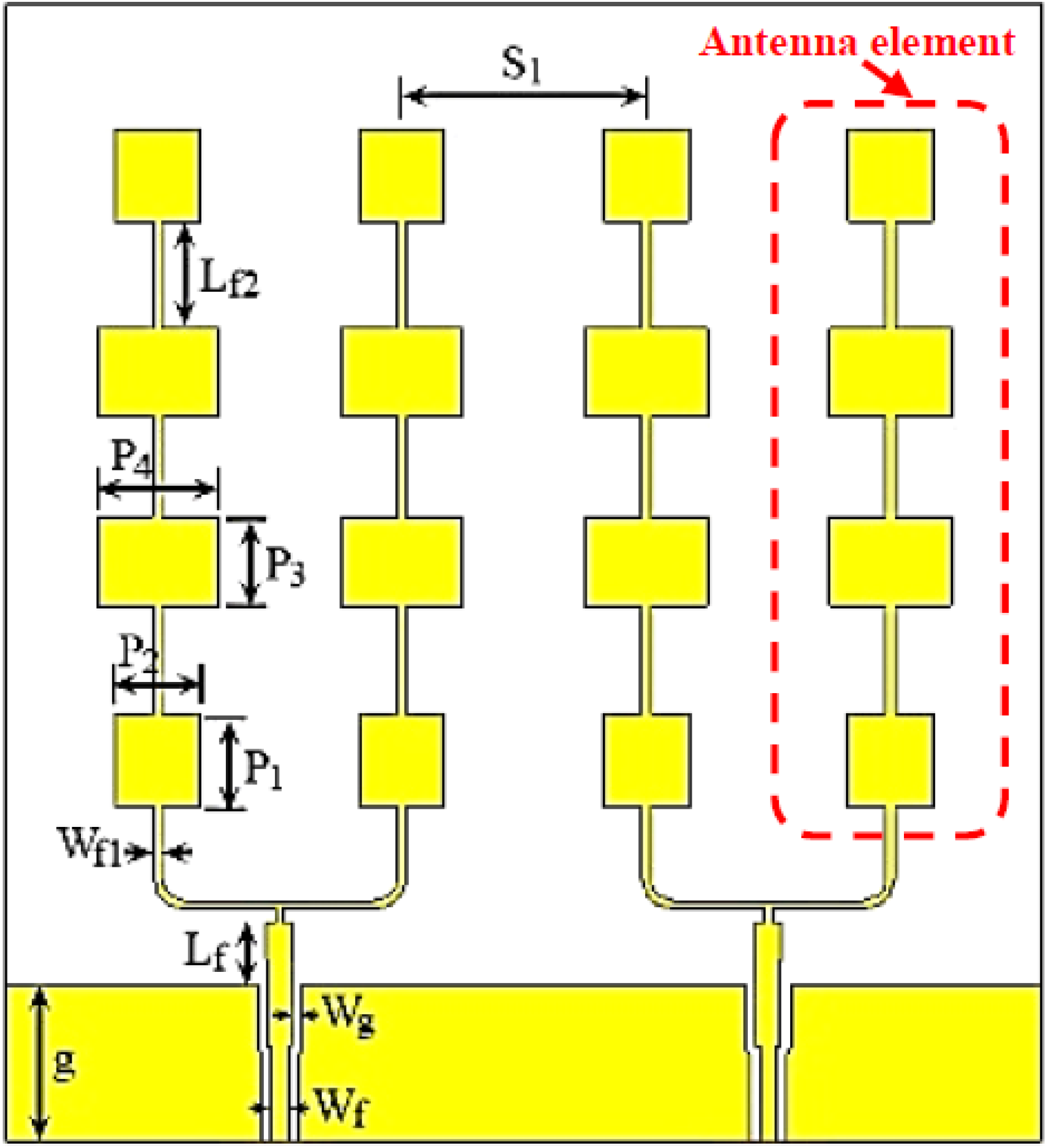
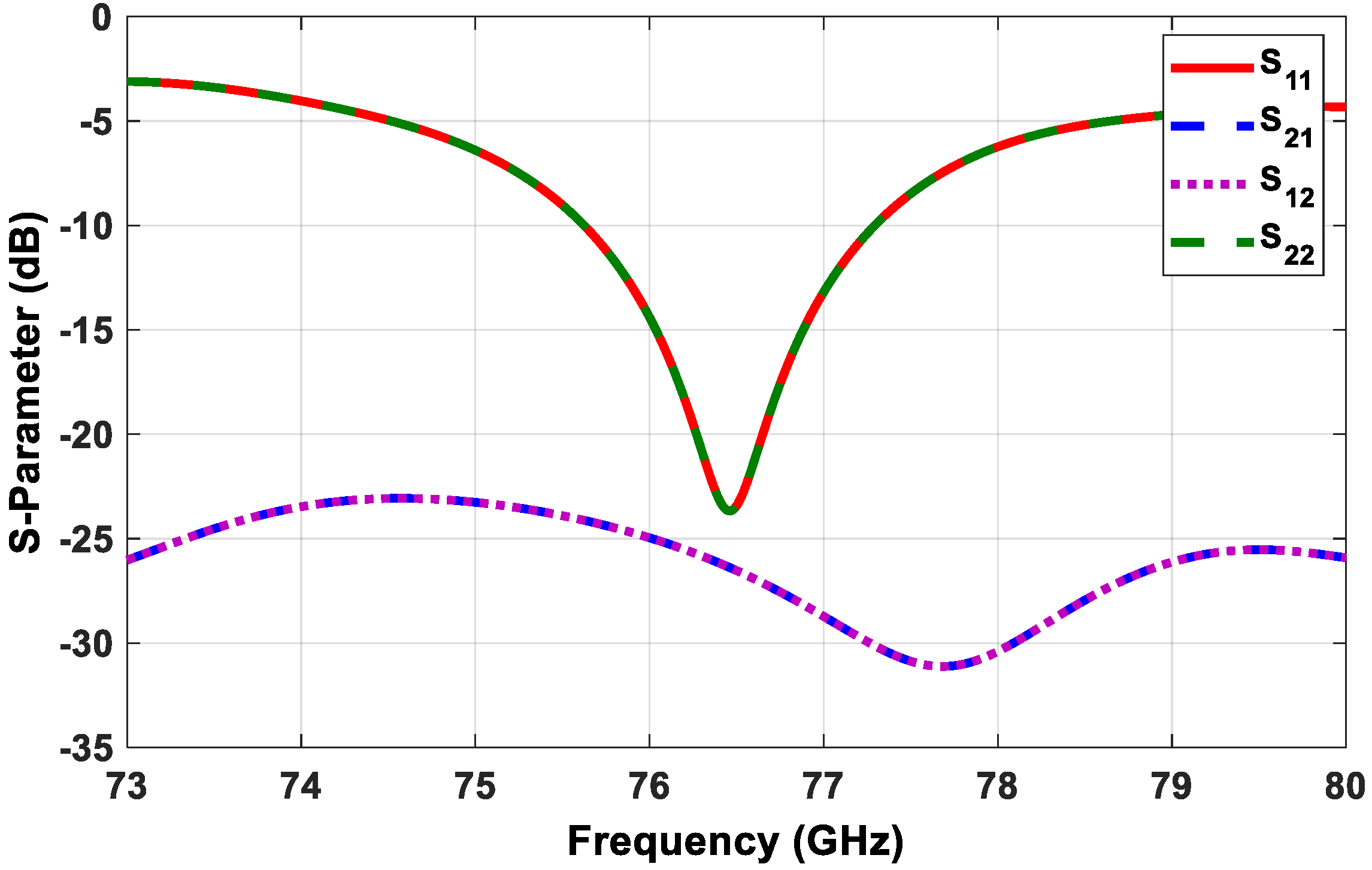

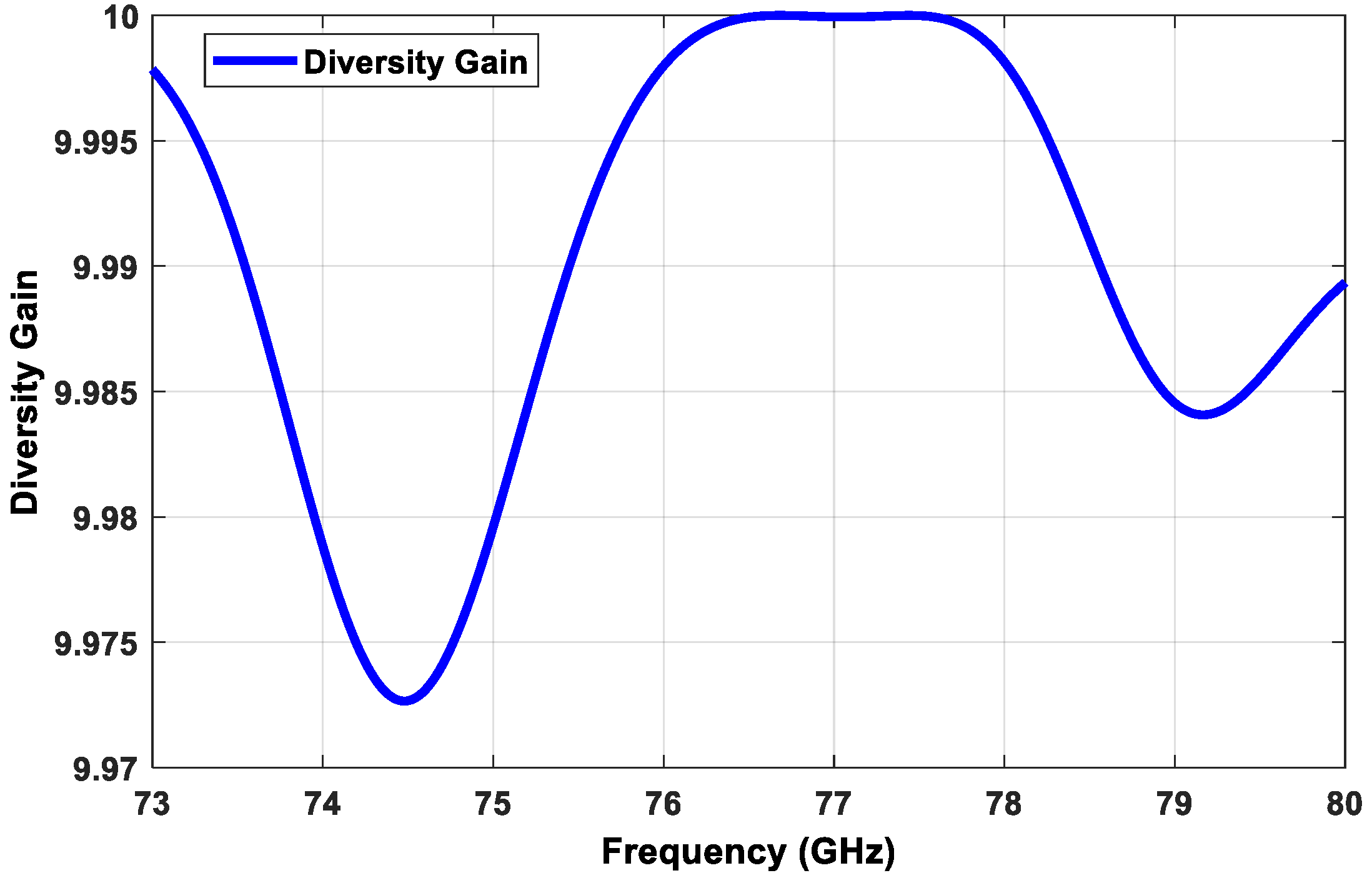
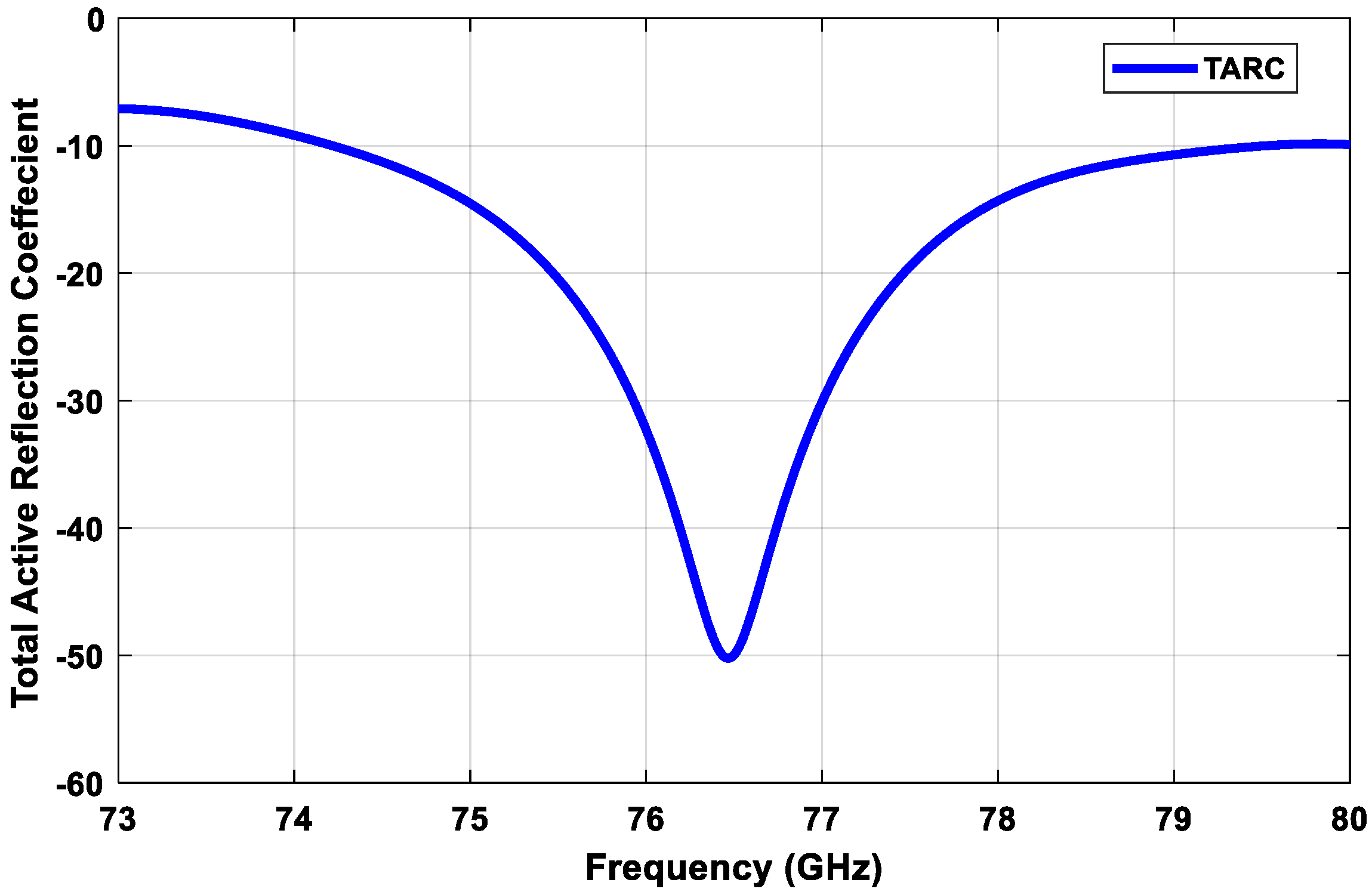
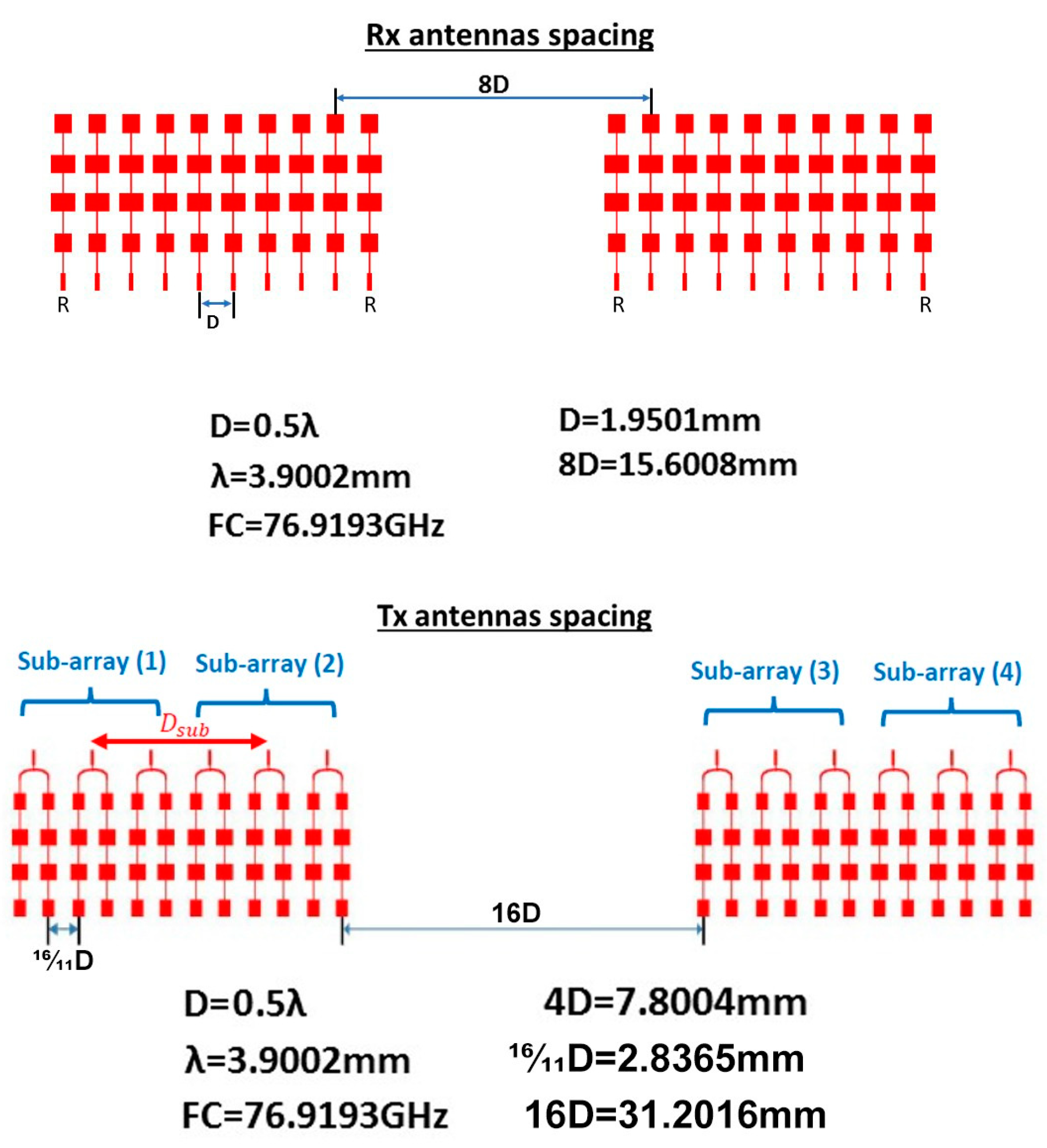
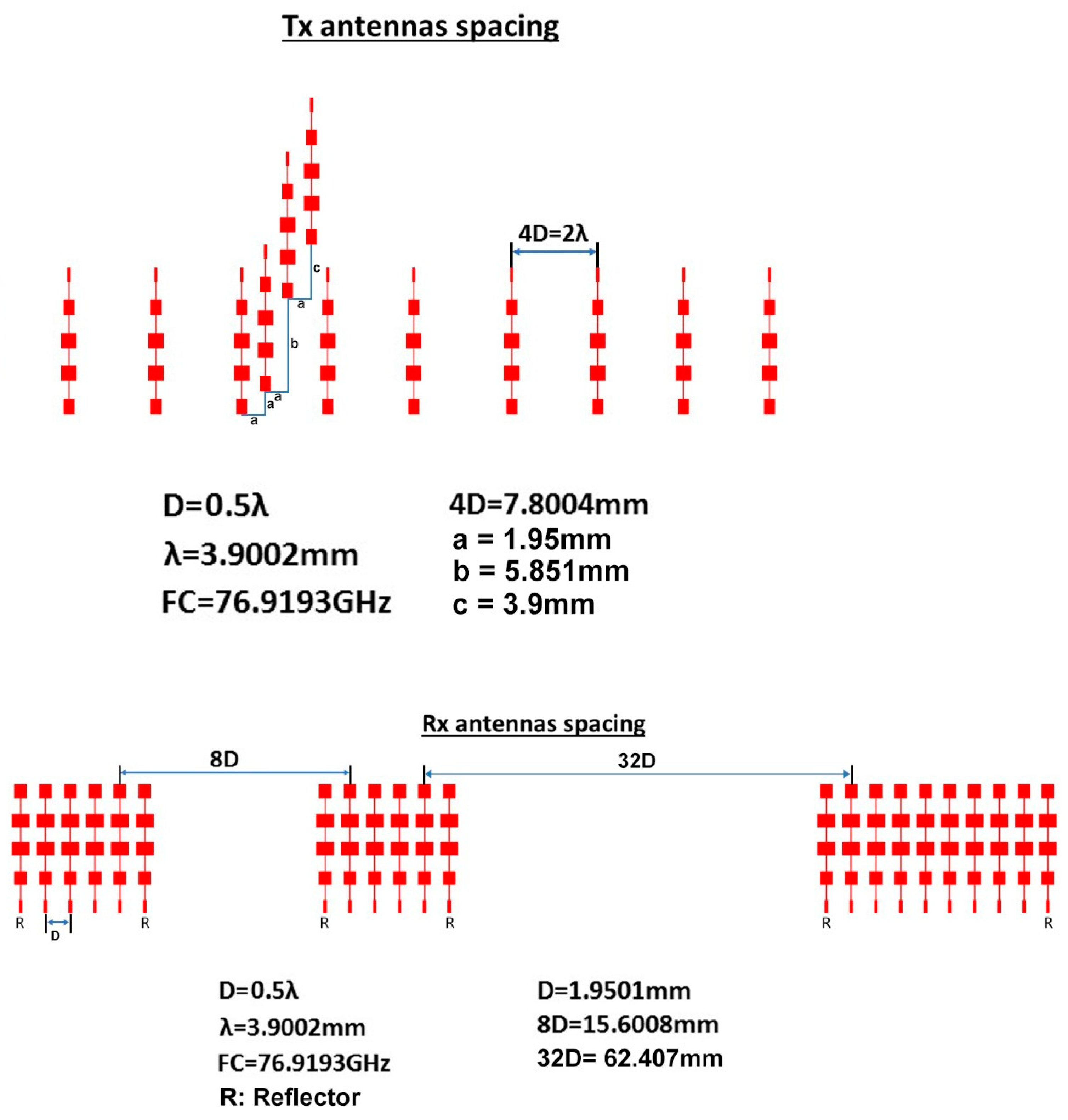

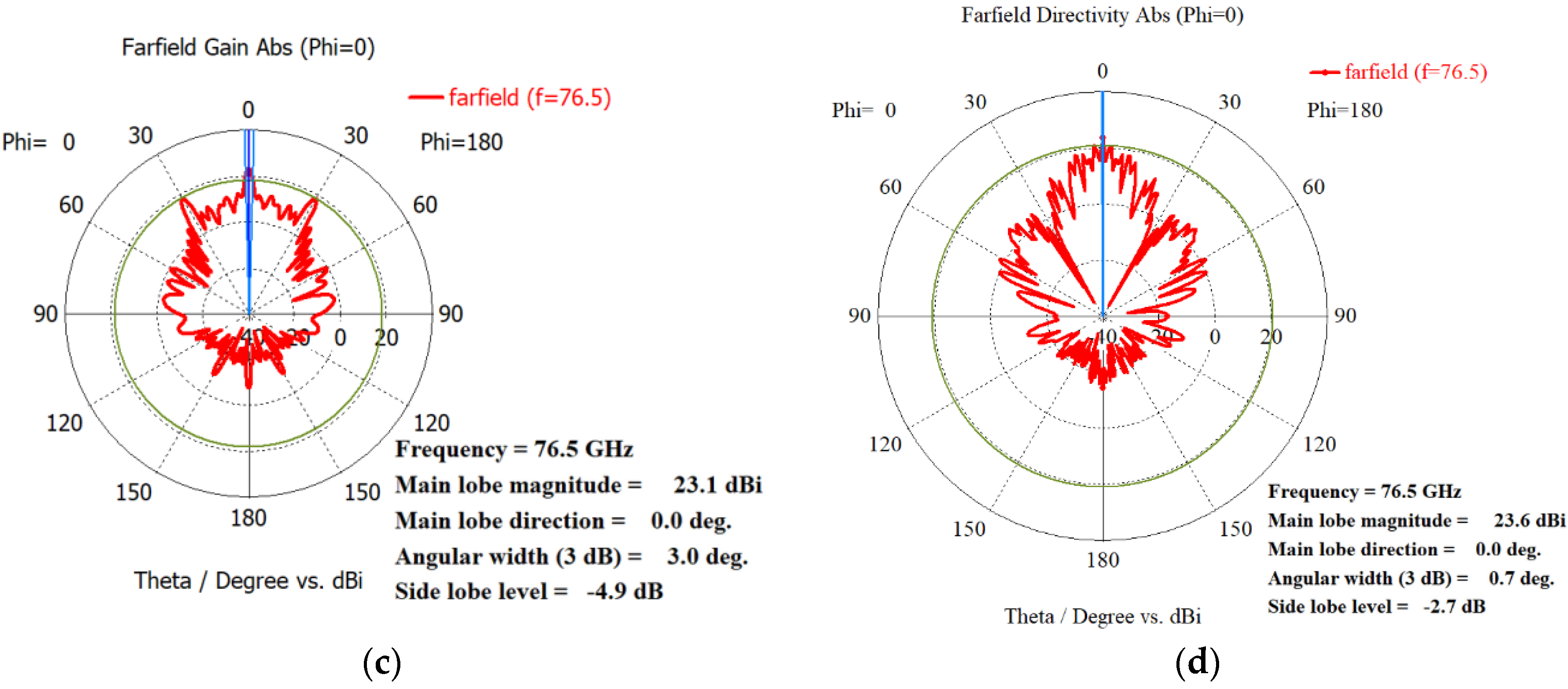
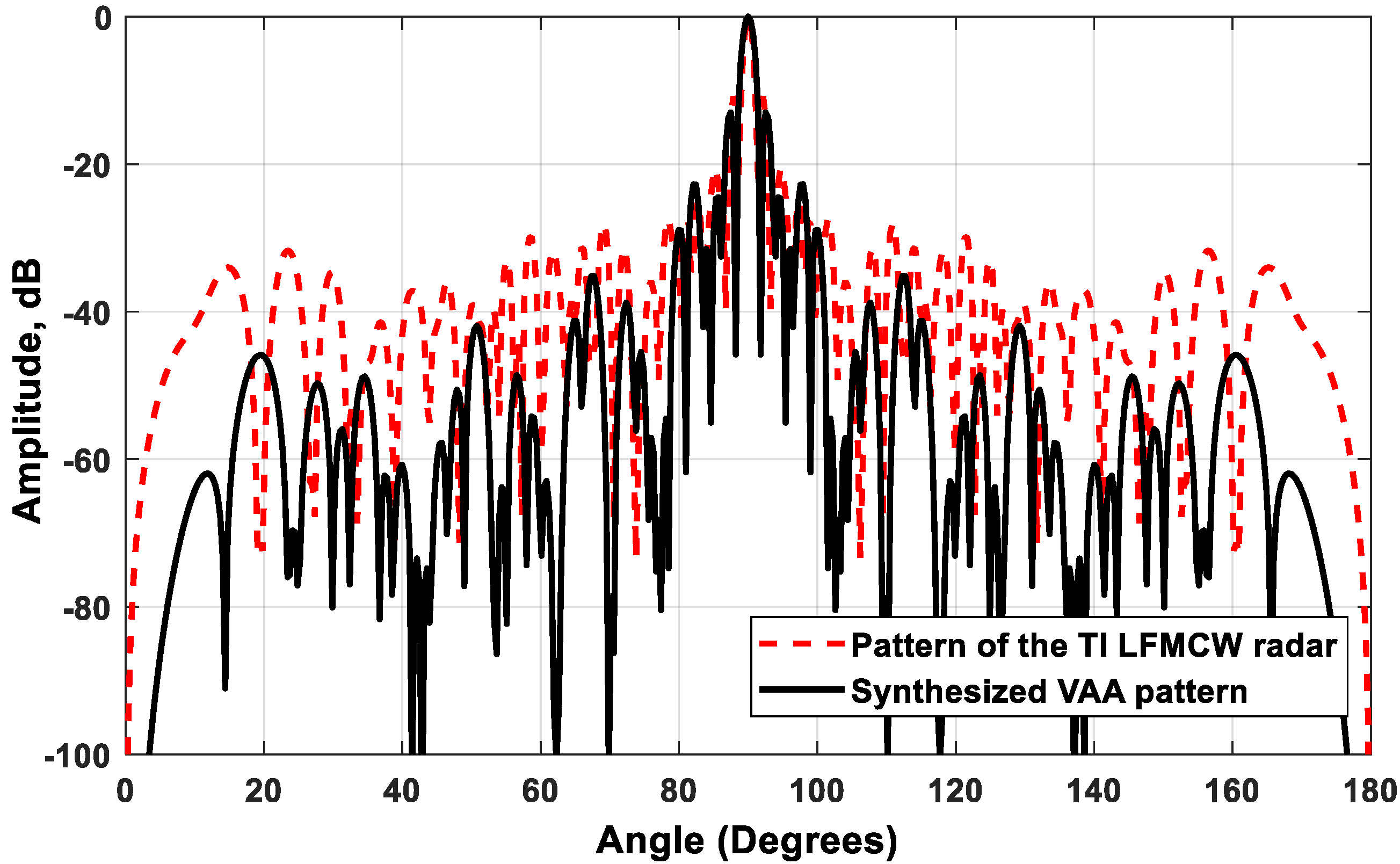



| Parameter | Parameter | ||
|---|---|---|---|
| g | 1.5918 | P2 | 0.88763 |
| Wf | 0.1893 | P3 | 0.923 |
| Wg | 0.1056 | P4 | 0.12424 |
| Lf | 0.09016 | Lf2 | 1.1092 |
| Wf1 | 0.0888076 | S1 | 2.517 |
| P1 | 0.9584 |
Publisher’s Note: MDPI stays neutral with regard to jurisdictional claims in published maps and institutional affiliations. |
© 2021 by the authors. Licensee MDPI, Basel, Switzerland. This article is an open access article distributed under the terms and conditions of the Creative Commons Attribution (CC BY) license (http://creativecommons.org/licenses/by/4.0/).
Share and Cite
Abdullah, H.; Mabrouk, M.; Abd-Elnaby Kabeel, A.; Hussein, A. High-Resolution and Large-Detection-Range Virtual Antenna Array for Automotive Radar Applications. Sensors 2021, 21, 1702. https://doi.org/10.3390/s21051702
Abdullah H, Mabrouk M, Abd-Elnaby Kabeel A, Hussein A. High-Resolution and Large-Detection-Range Virtual Antenna Array for Automotive Radar Applications. Sensors. 2021; 21(5):1702. https://doi.org/10.3390/s21051702
Chicago/Turabian StyleAbdullah, Haythem, Mohamed Mabrouk, Ahmed Abd-Elnaby Kabeel, and Amr Hussein. 2021. "High-Resolution and Large-Detection-Range Virtual Antenna Array for Automotive Radar Applications" Sensors 21, no. 5: 1702. https://doi.org/10.3390/s21051702







